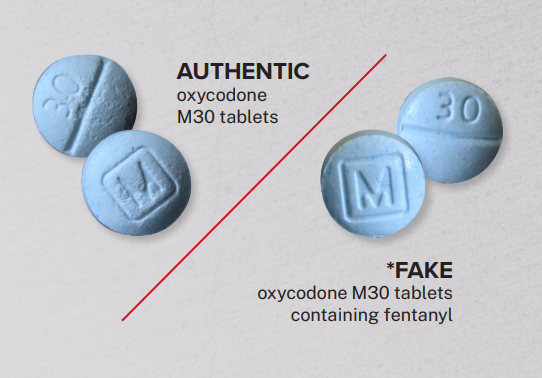(Updated 2025 November)
 Opioid overdoses continue in our community. Overdoses can happen in unexpected situations – a social gathering, a school event, with a friend or family member, or other community event. Sadly, drug overdoses are a leading cause of unintentional death among children in the United States.
Opioid overdoses continue in our community. Overdoses can happen in unexpected situations – a social gathering, a school event, with a friend or family member, or other community event. Sadly, drug overdoses are a leading cause of unintentional death among children in the United States.
As a parent or caregiver, you play a vital role in educating your family members to make safe and healthy decisions. Being mindful of substances in your household and community could save a child's life. Use the information and online resources below to get smart about fentanyl and fake pills and then use what you have learned to protect the young people in your care.
- What is fentanyl? It is a deadly synthetic opioid that is being pressed into fake pills or cut into heroin, cocaine, and other street drugs. It is 50 times more potent than heroin. It’s undetectable by sight, smell, or taste.
- What are fake pills? Fake pills are made to look like OxyContin®, Xanax®, Adderall®, and other pharmaceuticals. These fake pills contain no legitimate medicine. Fentanyl is also made in a rainbow of colors so it looks like candy. It can also be found in party drugs like cocaine and MDMA.
 Why is fentanyl so dangerous? U.S. Drug Enforcement Administration lab testing reveals that seven out of every ten fake pills with fentanyl contain a potentially lethal dose (2 milligrams) small enough to fit on the tip of a pencil.
Why is fentanyl so dangerous? U.S. Drug Enforcement Administration lab testing reveals that seven out of every ten fake pills with fentanyl contain a potentially lethal dose (2 milligrams) small enough to fit on the tip of a pencil.
- How would my child get fentanyl?
- Drug traffickers are using social media to advertise drugs and conduct sales even to teenagers. Learn about emoji codes used on social media.
- Young children may get into unsecured medications or illicit substances laced with fentanyl and even share them with others. A baby could find a pill or powder on the floor and put it in their mouth. Even the powdery residue left on surfaces can be harmful if ingested. It’s important to safely store and dispose of unused medications in your home, and to be mindful of situations where your children may be exposed to unsecured substances.
- What are the physical and mental effects of fentanyl? Fentanyl use can cause confusion, drowsiness, dizziness, nausea, vomiting, changes in pupil size, cold and clammy skin, coma, and respiratory failure leading to death.
- What are the signs of overdose?
- Face is pale or clammy
- Breathing is infrequent or has stopped
- Deep snoring or gurgling (death rattle)
- Unresponsive to any stimuli
- Slow or no heart rate and/or pulse
- Bluish purple, or ashen skin color
- Fingernails turn blue or blue-black
- What do I do in the case of an overdose? Call or text 9-1-1 if the situation is immediately life-threatening. Fairfax County Fire and Rescue personnel carry medication that can prevent death from an opioid overdose.
- What can I do to become better prepared? Take a virtual REVIVE! training to learn what to do in an overdose situation, how to administer naloxone (Narcan) nasal spray to reverse an opioid overdose and what to do afterward. Each attendee is eligible to receive naloxone at no cost. An educational training video is also available to learn about Opioids, Naloxone, and what to do if someone overdoses.
(Source: One Pill Can Kill | DEA.gov. Much of this information can be found in a printable flyer.)

